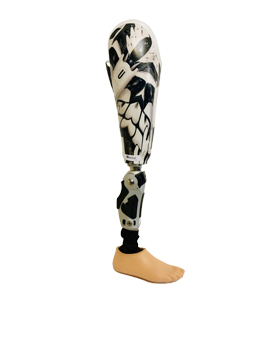Trans-femoral prosthesis

A prosthesis for a trans-femoral or above-knee amputation must provide maximum comfort at the stump (residual limb) and be compatible with the activity level desired by the user.
Following a clinical assessment of the user and of his or her living environment, and after determining the user’s goals and expectations, the prosthetist proposes the device best suited to the user’s needs, in full compliance with the prescription drawn up by the physician. Both the user and the prosthetist should work to develop a relationship based on trust and active listening to ensure an optimal outcome.
The various characteristics of the prosthesis must meet the requirements specific to the everyday activities the user wishes to perform (moving around the house, slow and fast walking, occupational and leisure activities, activities that require a waterproof device).
The prosthesis must deliver in a number of key areas. It must be: easy to fit, comfortable so that it can be tolerated right through the day, safe, reliable and either stable or compatible with high-performance sporting activity.
Various elements come together to produce a prosthesis:
- A liner is worn over the stump to create an interface between the stump and the socket. It improves comfort levels and absorbs the pressure forces on the stump.
- The socket is the rigid structure of the prosthesis which supports the user’s weight and transmits the motion of the stump to the prosthesis when walking.
- The knee and foot are key elements in delivering safety, comfort and a dynamic response for the benefit of the user. The factors that influence the choice of the prosthesis are: the user’s needs, physical abilities, weight, activity level, environment etc. and the length of the residual limb.
For users who mainly live in their home, a knee and a foot that provide maximum stability and safety are recommended. This type of femoral prosthesis lets the user move safely around the house.
For users whose goal is to be able to walk around their local neighborhood, a knee which provides good stability and an almost-natural gait combined with a moderate level of energy return is recommended. This type of femoral prosthesis lets the user negotiate sidewalks and curbs and walk on slightly uneven ground.
For more active users, a knee that provides dynamic stability, safety and ease of use when performing all types of activity, combined with an effective energy-returning foot, is recommended. This type of femoral prosthesis lets amputees regain their independence and rediscover the pleasure of engaging in their preferred activities.
- A femoral prosthesis may be fitted with a mobile ankle prosthesis in certain cases.
- One or more cosmetic covers that mimic the shape of the user’s other leg may be fitted over the prosthesis to restore a natural body shape and appearance. Several options are available, ranging from a foam with a simple outer finish to 3D-printed cosmetic covers finished with specially selected patterns and decorative designs.
The user must provide day-to-day care of the prosthesis in accordance with the instructions for use provided by the prosthetist. The liner and stump must be cleaned every day using special products. The user should arrange to see a prosthetist once a year for a general review and for servicing and maintaining the prosthesis. If users have any questions about the device they should not hesitate to contact their prosthetist or physician.
